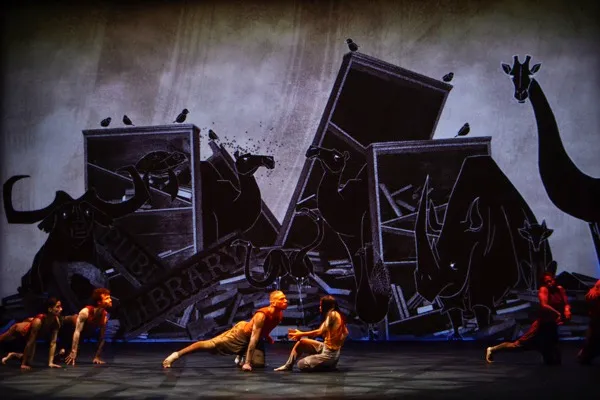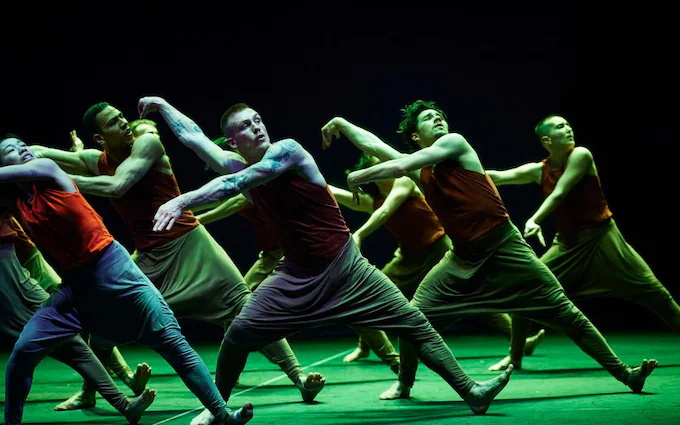3 February 2024. Canberra Theatre
Below is a slightly expanded review of Jungle Book Reimagined originally published by Canberra’s City News on 4 February 2024.
English choreographer Akram Khan has made a name for himself as an artist who pushes boundaries and who looks for new ways of presenting well known stories. His 2016 production of Giselle, which he removes from its 19th century origins and sets in a modern context of migrant labour, is one example. So too is Jungle Book Reimagined which takes as a starting point Rudyard Kipling’s The Jungle Book, a collection of stories that, like Giselle, dates back to the 19th century. Jungle Book Reimagined points out how vulnerable we are as our climate changes and becomes catastrophic. The opening scenes are gripping as we see well-known buildings collapsing—Big Ben, the Eiffel Tower, and others—and we listen to emergency broadcasts about the situation.

In Act I we are introduced to Mowgli, a girl child in this production rather than the boy we encounter in Kipling’s book. She has been separated from her family when she falls off a boat that is taking the family away from their now uninhabitable home, made so as a result of rising water and other disastrous climate changes. The child is discovered by a pack of animals who eventually name her Mowgli and we follow the decisions made about her future by these animals. While some of the animals are represented by dancers, others, including Hathi a large and dominant leader of the elephants, and a line of mice who scurry across the downstage space at one point, are shown using line-drawn animation techniques created by director of animation Adam Smith.
In Act II other animals, who have come from human testing laboratories, attempt to have Mowgli teach them to become human and take on characteristics that they find may help them in some way as they become inhabitants of the earth, including the use of fire. But Mowgli eventually realises she must support the friends with whom she has found peace rather than give in to the demands of this group.
The story is told in large part by a soundtrack of voices from various actors, each representing a different character, with an original musical score from Jocelyn Pook. Many of the major events are presented in video form and have been created by technician and projectionist Matthew Armstrong. A particular feature of the video elements is the interaction that occurs between the human performers and the video footage.
But perhaps the most interesting aspect of Jungle Book Reimagined is that, for all intents and purposes, it is classed as dance. Khan, who has a Bangladeshi heritage, is well versed in the Indian dance style of kathak. The hybrid choreography he has developed in Jungle Book Reimagined is Western contemporary dance with kathak overtones, especially in some movements of the hands and fingers and the feet, which occasionally flex up with the heel remaining on the ground. The dance sections, which are interspersed throughout the two-hour production, are magnificently performed. There are some exceptional group sections and moments when a single character dances solo. The dancing is nothing short of spectacular.
But Jungle Book Reimagined defies characterisation as any specific theatrical genre. Given the animation, the voices, the songs and other such elements, it is definitely more than dance. It is not a play although the use of narrative techniques is a strong element throughout, perhaps as a representation of the fact the work is based on a written text? Nor is it an item of musical theatre even though song plays a part. It is hard to know how to pin it down other than to say it crosses boundaries in the most creative manner.
I did, however, find it difficult sometimes to follow the jumble of conversations that happened among the characters. I also found it frustrating that the sound often seemed to be coming from spots in the auditorium, which I guess was meant to make the production immersive, although to me it was distracting. While there were also parts of the show that probably needed a second viewing to fully understand the story, I nevertheless found Jungle Book Reimagined, and the transmission of its message for those who inhabit our earth, terrifyingly brilliant.
Here is a link to the City News version. See also my earlier post on this production.
Michelle Potter, 5 February 2024
Featured image: Scene from Jungle Book Reimagined. Photo: © Ambra Venuccio
